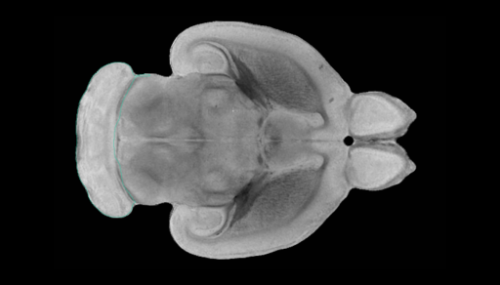Cerebellum of CIVM postnatal rat brain atlas. Credit: Neurolex
(Medical Xpress)—A team of researchers working at Oxford University has for the first time, caused an external decoding of an associative memory in a mammal. In their paper published in the journal Nature Neuroscience, the researchers describe how they caused an associative memory to form in test mice, and then the technique they used to recode it, to cause the memory to be removed.
As scientists continue to study the brain, they are learning more and more about the way memories are stored, or erased—just two years ago a team at MIT showed that it was possible to cause a memory to form in a mouse brain, forcing it to remember something that had never happened. In this new effort, the researchers have found a way to cause a mouse to stop associating a certain room with a pleasurable outcome—a form of recoding an associative memory.
The experiments consisted of first causing an associative memory to come about in test mice, by placing a small amount of cocaine in a room. After a short time, the mice came to prefer that room over another identical room that had only a saline solution to offer. Next, the researchers identified place cells in the hippocampus of the mice that were associated with the pleasant memory. That allowed them to genetically alter the mice such that the place cells would become light sensitive. The team than inserted light feeding fiber cables into the brain area and switched them on while the mice were once again allowed to enter the room that had once held the cocaine and found that the mice no longer preferred it to the room with the saline—the associative memory had been lost. The team also found that other unassociated place cells became active which cause the mouse to unknowingly create a new cognitive map, sans association with a room that had once held a pleasurable memory.
The team claims that theirs is the first experiment to show that it is possible to recode a memory in a mammal using external techniques. They note that it also confirms what is known as the engram theory of memory, which posits that memories are stored biophysically and come about due to biochemical changes in brain areas.
More information: Stéphanie Trouche et al. Recoding a cocaine-place memory engram to a neutral engram in the hippocampus, Nature Neuroscience (2016). DOI: 10.1038/nn.4250
Abstract
The hippocampus provides the brain's memory system with a subset of neurons holding a map-like representation of each environment experienced. We found in mice that optogenetic silencing those neurons active in an environment unmasked a subset of quiet neurons, enabling the emergence of an alternative map. When applied in a cocaine-paired environment, this intervention neutralized an otherwise long-lasting drug-place preference, showing that recoding a spatial memory engram can alleviate associated maladaptive behavior.
Journal information: Nature Neuroscience
© 2016 Medical Xpress
























